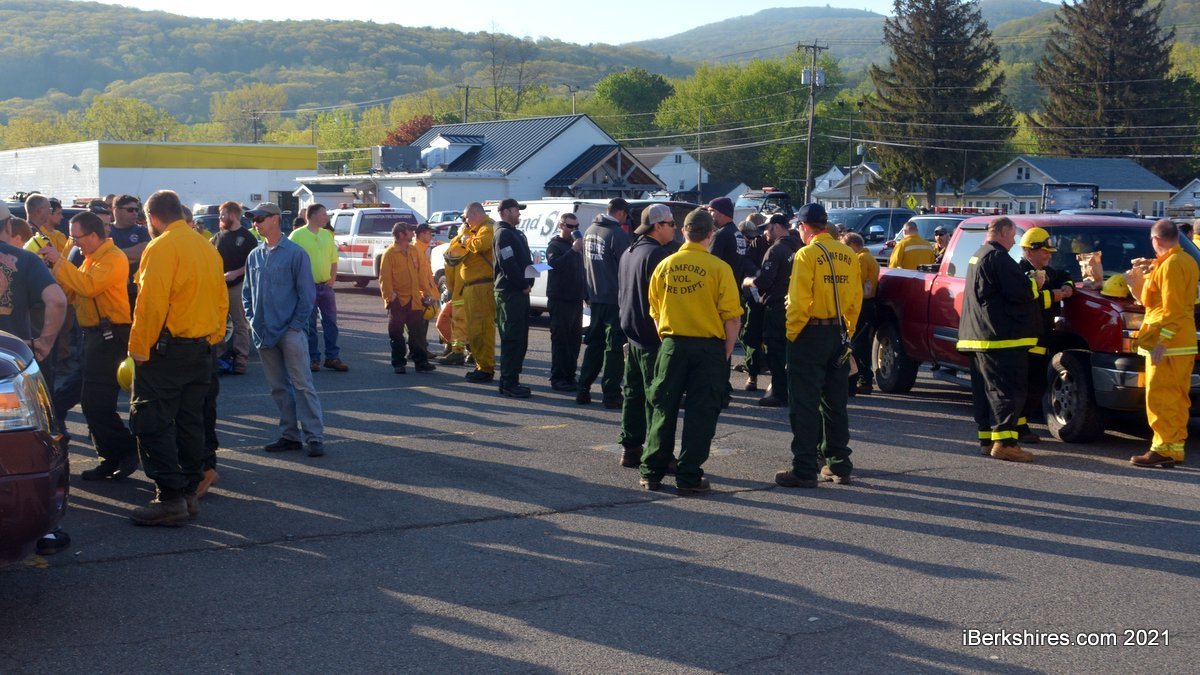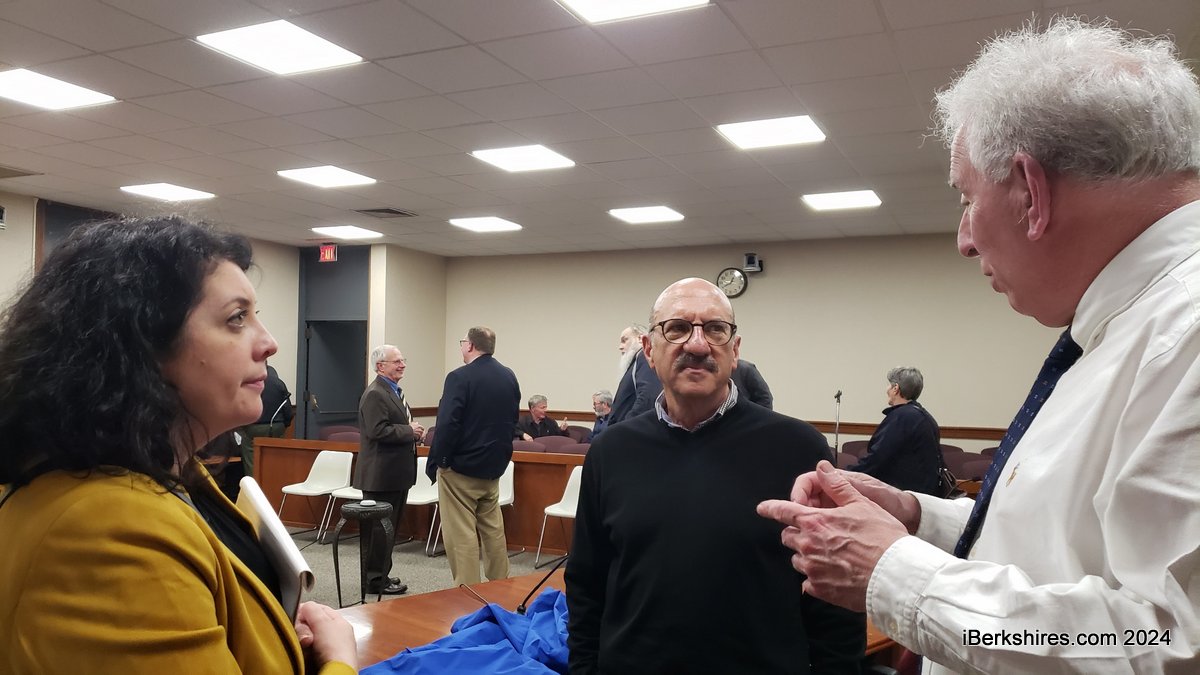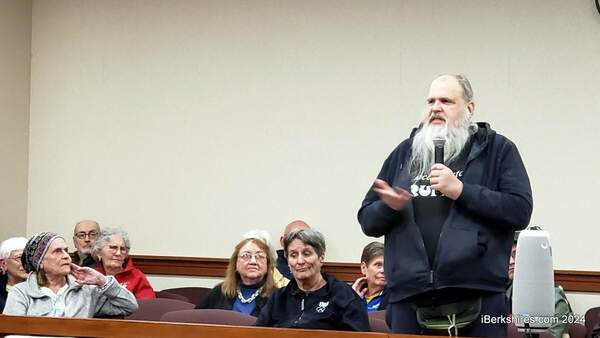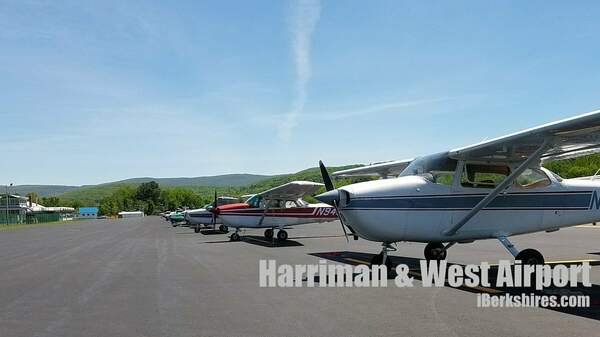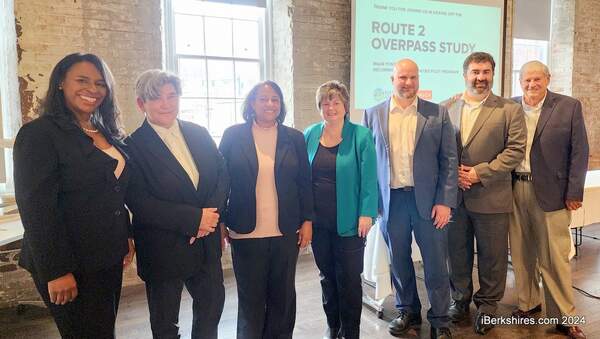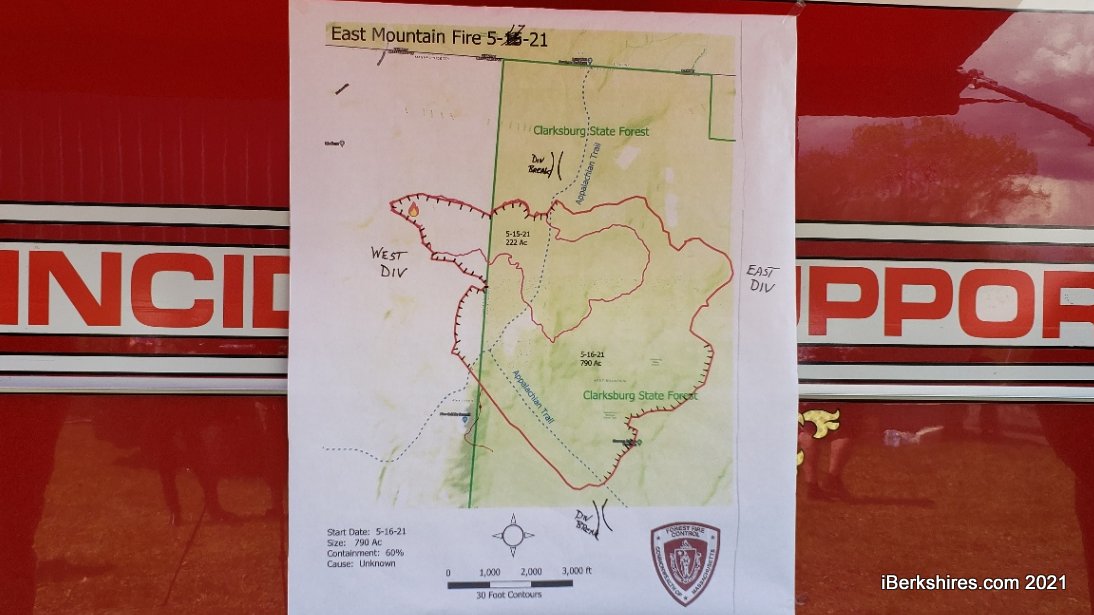
A map of the fire shows how far it expanded from Friday night over the weekend.
WILLIAMSTOWN, Mass. -- A spokesperson for the Massachusetts Department of Fire Services midday Tuesday confirmed that the brush fire that started Friday on East Mountain did not expand overnight on Monday.
"They are continuing to transition, as they hoped to, into mop up and control, patrolling the perimeter, as they continue to make progress," Jennifer Mieth said.
Mieth said it is her understanding that an estimated 947 acres burned in the fire, which moved progressively south and east across Pine Cobble and into Clarksburg State Forest.
Late Tuesday morning, no smoke was visible in the ridgeline from the North Adams water treatment plant on Pattison Road, which had been used as a site for a command center on Sunday and Monday, in part because of its elevation and the view it afforded of the fire.
At the close of yesterday's operations, the fire was estimated to be about 75 percent contained, Mieth said.
Mieth did not immediately know how many fire personnel are currently in the woods participating in the mop-up activities.
This story will be updated.
NORTH ADAMS, Mass. — More than 120 firefighters from 19 departments are now battling the wildland fire that's spread over 800 acres on East Mountain and in Clarksburg State Forest
Williamstown Fire Chief Craig Pedercini and State Fire Warden David Celino explained at a press conference Monday afternoon what they are doing to knock down such a large fire in difficult terrain.
"Wildland fires are complex especially in terrain like this," Celino said.
The fire started Friday night off Henderson Road in Williamstown and moved over East Mountain and Pine Cobble. By Saturday, the blaze covered about 222 acres on an east/west axis along the ridge. By late Sunday it had spread south and west and nearly quadrupled in size to 790 acres Monday morning. Fire officials expected that acreage to grow at the end of the day Monday even though the fire was about 75 percent contained.
A small army of firefighters from Berkshire County and Southern Vermont spent the weekend with rakes working to control the fire.
Celino presented a map using geographic information system, or GIS, that outlined different perimeters they have been able to create over the weekend.
He said fire "loves" inclines and this particular fire made its way up the Pine Cobble Summit, from where it then moved north into a "bowl" like terrain.
The fire is fueled by dry surface materials such as twigs and leaves. Firefighters have to create fire lines, or gaps, by raking and pulling back the vegetation to prevent spread. They have to flank the blaze and clear an 18-24 inch perimeter around the fire's edge. With no material to consume, the fire should fall back into itself and stop spreading.
Celino said this is not easy work and the difficult terrain is difficult to maneuver.
"It is steep and it is pretty rugged. It is not accessible by an engine and you have to go up by foot or take a UTV," he said, referring to the utility terrain vehicles that have been used to access the woodland interior since Friday night.
Celino said these fire lines become can be compromised by wind events. If wind blows the material back into the fire or an ember jumps the fire line, firefighters can lose control of their perimeter
In North Adams, firefighters were entering the woods via the top of Wood Street. Throughout the day firefighters from various departments were making their way up and down the path. Muster centers have been set up at several sites, including East Mountain Sportsmen's Club on Henderson Road, Blackinton mill on Massachusetts Avenue, and the former Price Chopper on State Road.
Incident command set up at the city's water treatment plant on Pattison Road using a state Fire Services command vehicle. Pedercini said fire officials had availed themselves of the same site during the stubborn Clarksburg State Forest event in 2015. The high location provides a view of East Mountain and allows for good communications services on both sides of the ridge.
This is the largest fire by acreage the state has seen since 1999, said Celino, the largest fire the state has seen this year. It hasn't caused the most damage because no structures have been involved.
"We've had a number of wildfires this year already that were small that threatened, damaged and destroyed buildings and damaged homes," he said.
Last year's drought conditions pushed the fire season into November and and the dry ground detritus helped fuel more than 800 wildland fires.
"In springtime fire season we don't typically see that. It's still very moist underneath the leaf litter," Celino said. "The fire is not burning deep. What we are seeing is that the fuel on the surface, all those dead sticks, and debris and leaf litter ... the sticks and the logs up to 6 inches are abnormally dry for springtime and we think that's residual effect from the drought of 2020. And we're seeing that across New England especially in Southern New England."
He said there is some concern when there are trends of low precipitation, low humidity and drying winds — as it has been this week — about fire events and behavior. Fires that burn deep can be difficult to put out, like one in Leverett last year that burned for 30 days.
This fire is similar to the 2015 fire, he said. "The fire has now burned into the imprint of that fire about five years ago. We are seeing a lot of the same characteristics."
Celino said there is still some moisture under the leaves in some areas. This thankfully is causing the fire some pause, he said, and this was also the case in 2015.
Pedercini said firefighters have been taking the nights off. The fire is currently not a threat to any structures or populations so there is no reason to risk firefighter safety.
He said the challenging terrain becomes far more dangerous at night when visibility is low.
"You can't see what you are walking into," he said. "You have burning snags and dead trees that create a real hazard at night."
He added that the air support provided by the State Police and National Guard has been a huge help and has allowed firefighters to really make some ground on the fire.
He also praised the volunteer firefighters, many of whom have taken the day out of work to continue the fight.
Pedercini added that the community has also really stepped up with food and water donations. He said they are actually hesitant to accept any more food because their supply is so abundant.
"I think all we need right now is everyone's well wishes everyone has been very supportive," he said.
Once the fire is more under control, firefighters will switch to "control and security" and "mop up" the perimeter, Pedercini said, and that the fire will likely smolder for days after it is extinguished.

